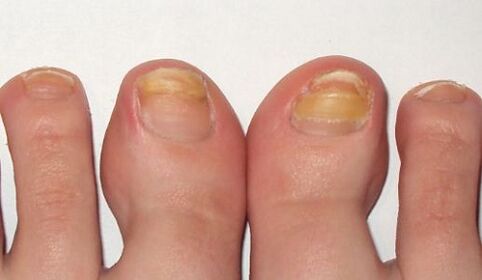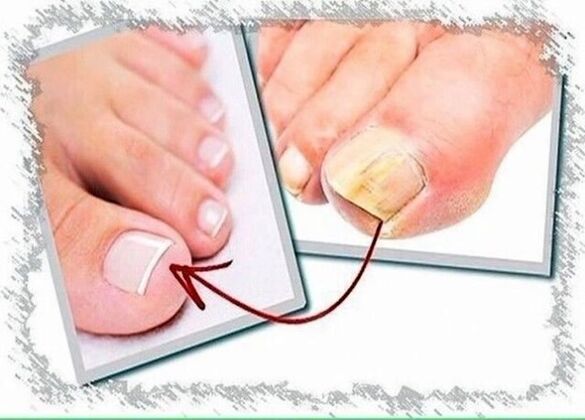Nail fungus (nail mycosis) is an infectious disease that affects every 5 adults on the planet. Infection occurs very quickly and occurs through pathogenic fungi. You can "catch" the virus if you wear someone else's shoes or ignore hygiene rules, as well as when you go to swimming pools, saunas, etc. Causes of fungus on toenails can be diabetes, poor circulation in the legs, weakened immunity, damaged nails, excess weight, and excessive sweating. How to identify nail fungus and what symptoms indicate the manifestation of the disease? We will discuss this issue in this article.
Nail fungus usually occurs on the feet and less often on the hands, but it can move from one foot to the other hand and from finger to finger. The disease appears to be mild, but it is actually very "survival", causing physical and mental inconvenience. The treatment of fungus is a very painstaking and lengthy process, and if the disease is not detected in time or the symptoms are ignored, then serious violations can occur: the fungus rapidly strengthens on the nails and penetrates the internal organs, where it can cause serious damage. Therefore, in order to diagnose and identify toenail fungus in a timely manner, it is necessary to know the first signs of toenail fungus. what are these?
signs of fungus on the feet
Generally, there is no noticeable change in the initial stage, but if that moment is missed, then diagnosis and treatment can become problematic. So how to identify nail fungus? Signs or symptoms of nail fungus include:
- Change the structure of the nail. Discolored (yellowing), brittle, rough, and cloudy nails.
- Pain in the affected area. The site where the fungus appears can be injured when it comes into contact with the shoe.
- Itching and burning of the skin. The skin around the infected nail becomes red and itchy.
- fall off the nail. In advanced stages, fungal-infected nails can fall off.
Nail fungus has 4 stages:
- The initial stages of nail fungus are almost never diagnosed (only in medicine). Barely visible white streaks appear on the nail plate, which indicates the presence of fungus.
- The second feature is a change in the appearance of the nail plate (you can identify it yourself). Nails turn yellow, cloudy, and chipped.
- The third manifestation is marked deformation of the nails, sometimes even partial loss. Additionally, the skin around the fingers begins to itch, burn, and peel.
- The fourth is the busiest. The affected skin begins to burst, become wet, and if left untreated, open wounds that do not heal.
fungal cause

So why does this fungus appear? Microorganisms called fungi (skin germs) are responsible for the damage that fungi do to the body. And a certain environment allows them to multiply, so the fungus occurs because of moisture and heat, which is formed by wearing shoes or synthetic socks that don't allow air to pass through, if you do, don't dry your feet after washing, damage your nails- When the nail plate is cut under the root, wearing tight shoes will only cause the nail to weaken, such as acrylic or gel varnish.
So what does a fungus-affected nail look like? They are yellow, tarnished, broken and partially exfoliated. If you've seen all or some of these nail fungus symptoms, you should consult a specialist right away, as self-treatment is just a waste of precious time.
Nail fungus won't go away by itself, it will attack your body step by step, weakening it. This is why one of the main and most important symptoms of toenail fungus is its systemic nature.
Causes of Treating Nail Fungus
So, the first symptoms are recognized, and you've gone to the doctor. A dermatologist or mycologist must first determine the type and extent of the disease (by taking a sample of the affected tissue) and make a diagnosis, and then prescribe treatment. According to the degree of damage to the nail, it is divided into normal nutritional mycosis (when the nail color changes), hypertrophic mycosis (the nail becomes cloudy and thickening), and atrophic mycosis (except in terms of color and deformation, it willNail chipping and falling off occur).
Treatment begins with topical preparations - these are ointments, patches and creams. Mostly, they are used to restore skin affected by fungus. To treat the nails, an antifungal varnish is used, which works by penetrating the nail plate and eliminating fungal pathogens. On the surface of the nail, these drugs form a film that prevents new infections from developing.
Dermatologists prescribe antifungal pills in cases where the disease is severe and topical medications are ineffective. It is worth noting that, in terms of their scope of action, their effects on the body are quite severe and there are many side effects. When an oral tablet is prescribed and taken, it is necessary to have a test so that the doctor can monitor the course of treatment and its effect on the body.
In some cases, specialists prescribe local medicines alongside antifungal pills. This occurs in the most severe forms of the disease or in patients of mature age, in which the recovery process is slower. Thanks to this treatment, the course of treatment is significantly reduced.
Folk fungus control
In addition to medication, traditional medicine is also widely used to fight fungi.
Improper treatment is a step in exacerbating the condition! It should be remembered that folk remedies do not cure nail mycosis, but only relieve the condition and relieve symptoms. They can be used as additional medical support.
No treatment (medication or folk) will be effective if you do not follow certain hygiene rules, this is what is recommended for fungal prevention.
Prevention of nail fungus

Preventing nail fungus is a fairly simple task given some standard hygiene requirements that everyone can and should follow:
- Wear socks or tights made of natural fabrics, change them daily, and wash, dry, and change socks if your feet get wet during the day (several times a day).
- Change shoes frequently. If you wear the same pair of shoes day in and day out, be sure to check (before going out) to see if they have dried out from your last walk. Keep in mind that a humid environment encourages the formation of fungi.
- When visiting manicurists and pedicurists, make sure the tools are in the correct form and condition. Ask an expert to sterilize all equipment at any time.
- Low immunity is a prerequisite for the emergence of fungi. Enrich your diet with healthy foods: eat more fruits and vegetables - they're full of vitamins, and don't sneak in garlic and nuts.
- Apply antiseptic. The most common of these is tea tree oil (a natural preservative), which is used to treat nails and the skin around them.
- Use only your personal hygiene items, as shared items are a surefire route for fungus. You must have your own toiletries (towels, brushes, combs, scissors); also, when going to public places (bathrooms, swimming pools, saunas, gyms) you must wear only your own shoes (even in the shower).
Prevention is the easiest way to avoid fungus! By following the simple (above) rules on a regular basis, you won't have to suffer long-term to get rid of "stubborn" nail fungus. Personal Hygiene: The Key to Health.
add up
So, how to tell the fungus on the nails? You need to study the appearance of your nails and watch for signs and symptoms of fungus. However, if nail mycosis is present, contact a dermatologist or mycologist immediately, but do not self-medicate to avoid missing valuable time. To treat the fungus with medication alone (under the supervision of a doctor), folk remedies can be used as an adjunct. Bottom line: You must follow personal hygiene rules (no matter how you think these are trivial things, some of which can be ignored) to avoid an unpleasant disease like nail fungus without confronting it.















